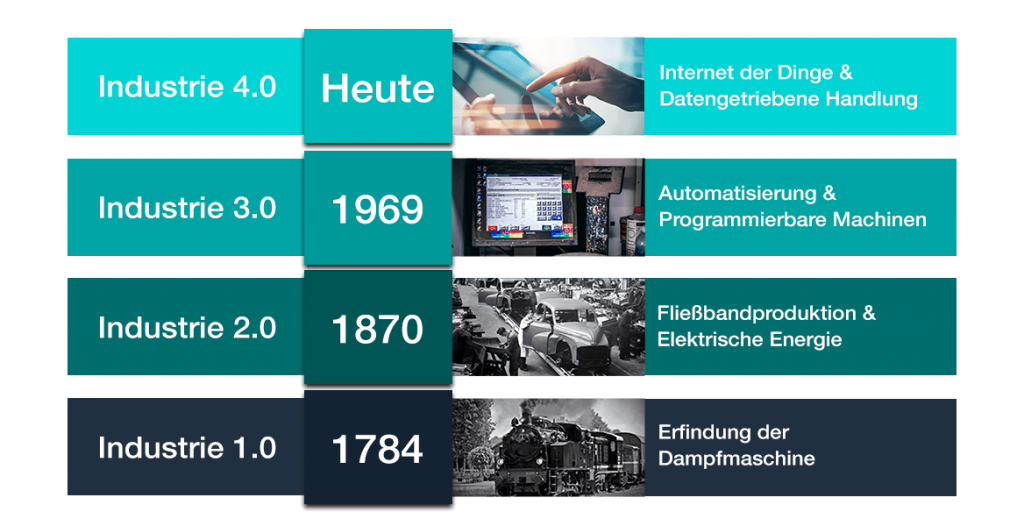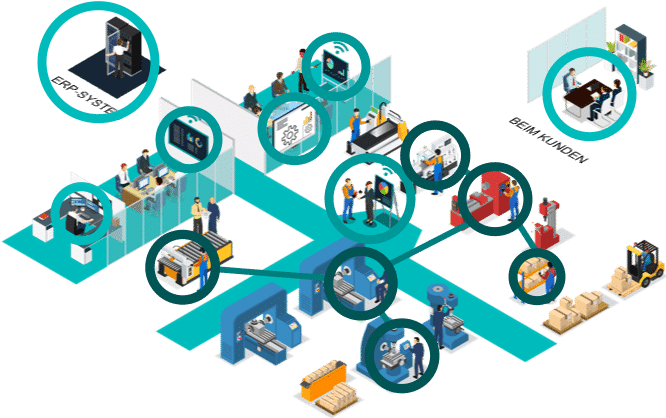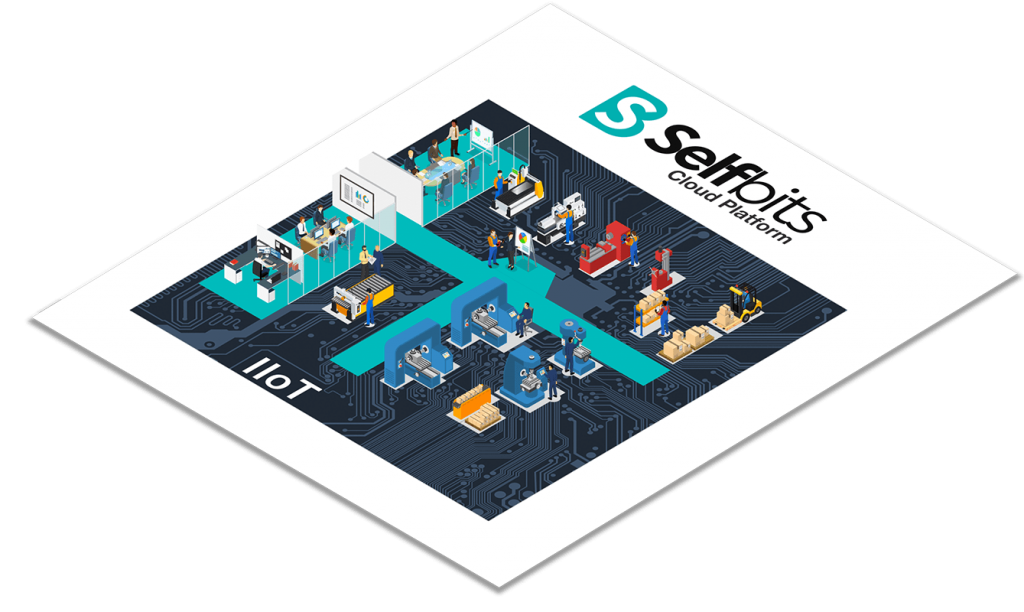Why Industry 4.0?
Industry 4.0 offers huge potential for increasing productivity. On this page we want to show you the possibilities of using this potential effectively in your own production. For this we provide explanations on terms of digitization, technological foundations and concrete application.
The term "Industry 4.0"
 The first industrial revolution took place with the invention of the steam engine in the 18th century. With the help of steam-driven power and power machines, a first real industrialization became possible.From 1870, the flow and conveyor belts and the electrical energy enabled industrial, labor-based mass production – the second industrial revolution.With the advent of electronics and information and communication technology into production, the third industrial revolution, which continues to this day, has begun. Automation is progressing in production. With the help of computer-aided logistics such as just-in-time deliveries and optimized production processes, modern, multi-variant series productions have become possible.The fourth industrial revolution is the complete, real-time networking of people, machines, products and workpieces. The focus is initially on the production. With the use of big data, forecasts can be made about the production process, faults can be detected early and the production process can be further optimized.
Ultimately, networking should be completed over the entire product life cycle. The resulting transparency and communication result in improved products or even completely new business models that meet customer needs in a targeted manner.
The first industrial revolution took place with the invention of the steam engine in the 18th century. With the help of steam-driven power and power machines, a first real industrialization became possible.From 1870, the flow and conveyor belts and the electrical energy enabled industrial, labor-based mass production – the second industrial revolution.With the advent of electronics and information and communication technology into production, the third industrial revolution, which continues to this day, has begun. Automation is progressing in production. With the help of computer-aided logistics such as just-in-time deliveries and optimized production processes, modern, multi-variant series productions have become possible.The fourth industrial revolution is the complete, real-time networking of people, machines, products and workpieces. The focus is initially on the production. With the use of big data, forecasts can be made about the production process, faults can be detected early and the production process can be further optimized.
Ultimately, networking should be completed over the entire product life cycle. The resulting transparency and communication result in improved products or even completely new business models that meet customer needs in a targeted manner.What makes Industry 4.0?

Central paradigms of Industry 4.0
The integration of the corporate IT infrastructure into a defined hierarchy with standardized interfaces is vertical integration. Horizontal integration refers to the link with the IT systems of customers, suppliers, external service providers and others. Together, this results in a holistic IT system that internally and externally handles all business transactions
Decentralized intelligence describes the capability of the machine park to provide relevant production data, such as stock levels or production parameters to a decentralized control system.
The decentralized control is the counterpart to the stationary and static PLC controls. Industrial Internet of Things solutions and cloud services enable geographically distributed flexible control.
In integrated digital engineering, all processes in the company, from development to production, are regarded as a holistic system. The goal is to create a complete digital image of the company. Due to the transparency gained, this promises productivity gains and simpler optimization.
Cyber-physical production systems describe a new production system in which information and communication technology is integrated into the machines, sensors and actuators.
Increasing competitive pressure and differentiation needs are drivers for further developments. Substitute or disruptive changes in the market environment due to new business models require further optimization potential to be discovered and used. At the same time, new, diverse customer needs arise, leading to new variants and increasing complexity costs. Industry 4.0 recognizes this instability and changeability as the reality of 21st century businesses. Based on integrated systems, it provides answers for companies in this environment.
Lean production and its principles have led to a significant increase in production efficiency in the 1990s. The consistent further development of pull mechanisms, just-in-time and quality awareness (such as Six Sigma) have made it possible to realize these productivity gains in almost all areas of the company.
Today’s short product life cycles and competitive pressures lead to the search for further efficiency gains that can no longer be achieved with Lean. Only with the use of modern information and communication technology, the variety of today’s products and the optimization of lot size 1 can be controlled by companies.
Then, intelligent workpieces store information about their processing and use. At the same time, they have an Internet connection with which they can receive updates, transmit usage data and individually regulate maintenance intervals. The individual production steps with their parameters are sent to the networked machine park via Industrial Ethernet. It then sends the realized production parameters, production quantities and other confirmation data back to the decentralized controller.
As a result, Industry 4.0 is creating a holistic system of products, business processes and high-quality services that enable new business models and expand product ranges.
In Industrie 4.0, people primarily assume the role of the controlling and decision-making body. They are involved in the production and control process via augmented reality and other man-machine interfaces.
Enabler for Industry 4.0 and why it has not yet arrived everywhere
The key driver for implementing Industry 4.0 is the availability of communications and information technology today. Cost-effective sensors, networked systems and network technology such as Industrial Ethernet enable economical operation of data acquisition in production and machine-to-machine communication (M2M communication) for the first time. Only with modern data systems, high transmission speeds and suitable IT architectures is it technically possible to map the complexity in discrete manufacturing and to control it decentrally.
With the broad and cost-effective availability of these technologies, customized mass production has also become possible in the discrete manufacturing of medium-sized companies.
However, this requires the further development of production towards an intelligent factory. It follows the teachings and principles of modern production systems such as lean management and generates further productivity gains through information and communication technology.
Smart Factory

The target image of Industry 4.0 is the intelligent factory: “Smart Factory”. There, machines, workpieces and people exchange information directly with each other. Information such as production quantities, confirmation data and production parameters are provided decentrally. Current orders from customers, supplier delivery data are entered in the system and can be used to optimize the production process. Repeat orders are automatically triggered, orders are scheduled and information is provided about delivery dates. In this system, humans primarily fulfill a controlling and decision-making authority. They monitor the production and control only in case of faults or other events. What is already customary in the process industry, thanks to closed systems and completely controllable variables, is now to be incorporated into discrete manufacturing.
We are looking forward to your contact!
Selfbits stands for useful and tailor-made software solutions in the area of IoT and Industry 4.0.
We provide our customers with detailed data collection and transparency in their own production.
The in-depth insights and resulting insights are used by our customers to sustainably increase their production efficiency.
As the “Research University in the Helmholtz Association”, the Karlsruhe Institute of Technology (KIT) creates and communicates knowledge for society and the environment.
Selfbits started as a spin-off at KIT. We continue to be closely associated with KIT, in particular the professorship of Prof. Weinhardt, the KIT Founders Forge and the Innovation and Relations Management (IRM).
EXIST is a funding program of the Federal Ministry for Economic Affairs and Energy (BMWi).
It supports the preparation of innovative technology-oriented and knowledge-based start-up projects for students, graduates and scientists. Selfbits was funded by EXIST from 2015 to 2016.